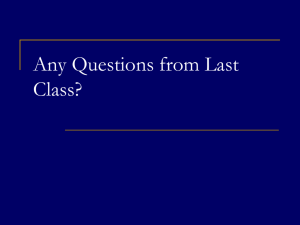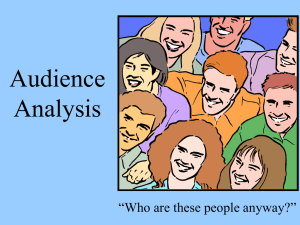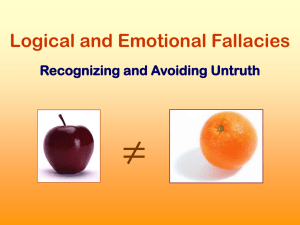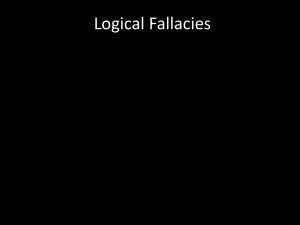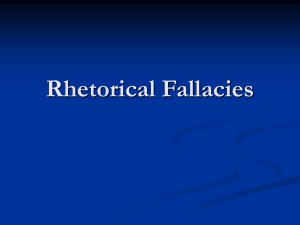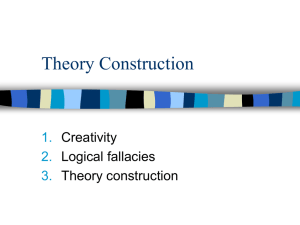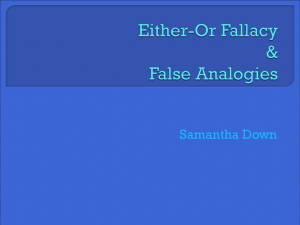Froeb_03 - Vanderbilt Business School
advertisement
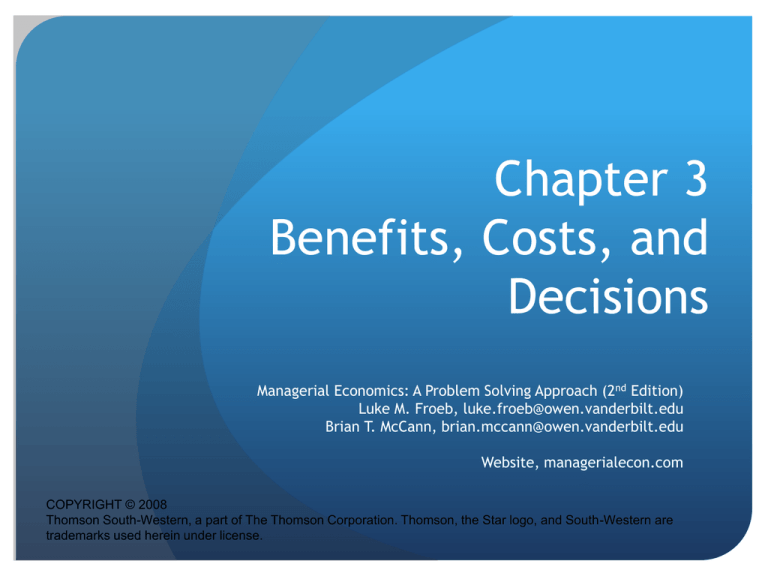
Chapter 3 Benefits, Costs, and Decisions Managerial Economics: A Problem Solving Approach (2nd Edition) Luke M. Froeb, luke.froeb@owen.vanderbilt.edu Brian T. McCann, brian.mccann@owen.vanderbilt.edu Website, managerialecon.com COPYRIGHT © 2008 Thomson South-Western, a part of The Thomson Corporation. Thomson, the Star logo, and South-Western are trademarks used herein under license. Chapter 3 – Summary of main points • Costs are associated with decisions, not activities. • The opportunity cost of an alternative is the profit you give up to pursue it. • In computing costs and benefits, consider all costs and benefits that vary with the consequences of a decision and only those costs and benefits that vary with the consequences of the decision. These are the relevant costs and benefits of a decision. • Fixed costs do not vary with the amount of output. Variable costs change as output changes. Decisions that change output will change only variable costs. Chapter 3 – Summary (cont.) • Accounting profit does not necessarily correspond to real or economic profit. • The fixed-cost fallacy or sunk-cost fallacy means that you consider irrelevant costs. A common fixed-cost fallacy is to let overhead or depreciation costs influence short-run decisions. • The hidden-cost fallacy occurs when you ignore relevant costs. A common hidden-cost fallacy is to ignore the opportunity cost of capital when making investment or shutdown decisions. • EVA® is a measure of financial performance that makes explicit the hidden cost of capital. • Rewarding managers for increasing economic profit increases profitability, but evidence suggests that economic performance plans work no better than traditional incentive compensation schemes based on accounting measures. Introductory anecdote: Armadillo Appliances • Armadillo Appliances switched steel suppliers because a new manufacturer offered a price $0.01/lb less than the old purchasing price. • Multiplied by the nine million pounds of steel used annually, AA anticipated $90,000 in savings • Instead – acquisitions costs increased by $75,000 • Why? What happened? • Discussion: Diagnose the problem. • Discussion: Come up with a proposal to fix it. Armadillo’s freight costs went up Coil Steel Procurement New Supplier Original Supplier $0.50/lb. Old Supplier $0.50/lb New Supplier $0.49/lb Material Cost Savings: $93,000/yr HOWEVER, Transportation Cost Increase: $170,000/yr Armadillo Old Supplier $77,000 Total Cost Increase Background: Types of costs • Definition: Fixed costs do not vary with the amount of output. • Definition: Variable costs change as output changes. • For Example: A Candy Factory • The cost of the factory is fixed. • Employee pay and cost of ingredients are variable costs. Total, Fixed, and Variable Costs Your turn • Are these costs fixed or variable? • Payments to your accountants to prepare your tax returns. • Electricity to run the candy making machines. • Fees to design the packaging of your candy bar. • Costs of material for packaging. Background: Accounting vs. Economic cost • Typical income statements include explicit costs: • Costs paid to its suppliers for product ingredients • General operating expenses, like salaries to factory managers and marketing expenses • Depreciation expenses related to investments in buildings and equipment • Interest payments on borrowed funds • What’s missing from these statements are implicit costs: • Payments to other capital suppliers (stockholders) • Stockholders expect a certain return on their money (they could have invested elsewhere) • “Profit” should recognize whether firm is generating a return beyond shareholders expected return • Economic profit recognizes these implicit costs; accounting profit recognizes only explicit costs Example: Cadbury (Bombay) • Beginning in 1978, Cadbury offered managers free housing in company owned flats to offset the high cost of living. • In 1991, Cadbury added low-interest housing loans to its benefits package. Managers moved out of the company housing and purchased houses. The empty company flats remained on Cadbury’s balance sheet for 6 years. • 1997 Cadbury adopted Economic Value Added (EVA)® • A capital charge appeared on division income statements • Senior managers then decided to sell the unused apartments after seeing the implicit cost of capital. • Discussion: How did this action increase profitability? Accounting costs for Cadbury Opportunity costs & decisions • Definition: the opportunity cost of an action is what you give up (forgone profit) to pursue it. • Costs imply decision-making rules and vice-versa • The goal is to make decisions that increase profit • If the profit of an action is greater than the alternative, pursue it. • Whenever you get confused by costs, step back and ask “what decision am I trying to make.” • If you start with costs, you will always get confused • If you start with a decision, you will never get confused • Discussion: What was cost of capital • To Bombay division?; to company? • How do we get GOAL ALIGNMENT? Relevant costs and benefits • When making decisions, you should consider all costs and benefits that vary with the consequence of a decision and only costs and benefits that vary with the decision. • These are the relevant costs and relevant benefits of a decision. • You can make only two mistakes • You can consider irrelevant costs • You can ignore relevant ones Fixed-cost fallacy • Definition: letting irrelevant costs influence a decision • Football game example – how does ticket price affect your decision to stay or leave at halftime? Should it? • Launching a new product – what if overhead deters a profitable product launch • Discussion: does your company include “overhead” in transfer prices? • Discussion: outsourcing agitator production • Diagnose problem using Decisions rights; evaluation metric; compensation scheme, • Try to fix it: how do you better align the incentives of the plant managers with the profitability goals of the company? Discussion: Outsourcing Hidden-cost fallacy • Definition: ignoring relevant costs when making a decision • Example: another football game • Discussion: should you fire an employee? • The revenue he provides to the company is $2,500 per month • His wages are $1,900 per month • His office could be rented out $800 per month • Discussion: Come up with examples of the hiddencost fallacy. Subprime mortgages • The subprime mortgage crisis of 2008 is a good example of the hidden-cost fallacy. • Credit-rating agencies failed to recognize the higher costs of loans made by dubious lenders. • Example: Long Beach Financial • Gave loans out to homeowners with bad credit, asked for no proof of income, deferred interest payments as long as possible. • Credit ratings didn’t reflect the hidden costs of risky loans, as a result many Wall Street investors purchased packaged risky loans and eventually went bankrupt when the debtors defaulted. Hidden cost of capital • Recall that accounting profit does not necessarily correspond to economic profit. • Discussion: Economic Value Added • EVA®= net operating profit after taxes minus the cost of capital times the amount of capital utilized • Makes visible the hidden cost of capital • The major benefit of EVA is identifying costs. If you cannot measure something, you cannot control it. • Those who control costs should be responsible for them. Incentives and EVA® • Goal alignment: “By taking all capital costs into account, including the cost of equity, EVA shows the dollar amount of wealth a business has created or destroyed in each reporting period. … EVA is profit the way shareholders define it.” • Discussion: can you make mistakes using EVA? • Does it help avoid the hidden cost fallacy? • Does it help avoid the fixed cost fallacy? Does EVA® work? • Adopting companies of EPP’s (+ four years) • ROA from 3.5 to 4.7% • operating income/assets from 15.8 to 16.7% • Indistinguishable from non-adopters • Bonuses increase 39.1% for EVA® firms • But 37.4% for control group • Interpretations • Selection bias? • NO, cheaper to use existing plans • Goal alignment, YES. • EVA® is no better or worse • Rival EPP’s • Bonus plans • Discussion: WHY? Psychological biases • Not enough information or bad incentives are not the only causes for business mistakes. Often psychological biases get in the way of rational decision making. • Definition: the endowment effect means that taking ownership of item causes owner to increase value she places on the item. • Definition: loss aversion – individuals would pay more to avoid loss than to realize gains. • Definition: confirmation bias – a tendency to gather information that confirms your prior beliefs, and to ignore information that contradicts them. • Definition: anchoring bias – relates the effects of how information is presented or “framed” • Definition: overconfidence bias – the tendency to place too much confidence in the accuracy of your analysis Alternate intro anecdote • Coca-Cola in the 1980s had very little debt, preferring to raise equity capital from its stockholders • Company had a diversified product line, including products like aquaculture and wine. These other businesses generated positive profits, earning a ten percent return on capital invested. • The company, however, decided to sell off these “under-performing businesses” • Why? • At the time, soft drink division was earning 16 percent return on capital • The “opportunity cost” of investing in aquaculture and wine is the foregone profit that could have been earned by investing in soft drinks • A dollar invested in aquaculture and wine is a dollar that was not invested in soft drinks • Divisions sold off and proceeds invested in core soft drink business 23 1. Introduction: What this book is about Managerial Economics 2. The one lesson of business 3. Benefits, costs and decisions Table of contents 4. Extent (how much) decisions 5. Investment decisions: Look ahead and reason back 6. Simple pricing 7. Economies of scale and scope 8. Understanding markets and industry changes 9. Relationships between industries: The forces moving us towards long-run equilibrium 10. Strategy, the quest to slow profit erosion 11. Using supply and demand: Trade, bubbles, market making 12. More realistic and complex pricing 13. Direct price discrimination 14. Indirect price discrimination 15. Strategic games 16. Bargaining 17. Making decisions with uncertainty 18. Auctions 19. The problem of adverse selection 20. The problem of moral hazard 21. Getting employees to work in the best interests of the firm 22. Getting divisions to work in the best interests of the firm 23. Managing vertical relationships 24. You be the consultant EPILOG: Can those who teach, do?
